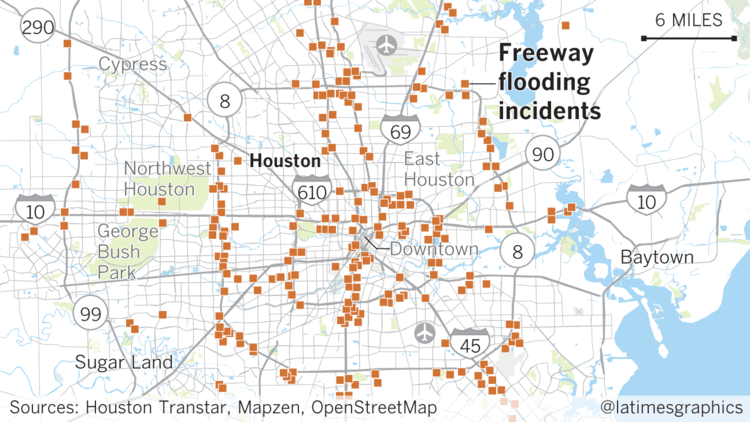Nicole Gelinas on the crucial differences between the situation faced by New Orleans during Hurricane Katrina and that currently faced by Houston after being inundated by Hurricane Harvey:
The Houston region has received record rain, more falling in less than a week than it usually does in a year, and at least 30 people, including a Houston police officer, have died. Harvey, however, is not Katrina. One measure of this difference is in electricity provision. After Katrina, New Orleans was almost entirely without power for weeks. In Houston, by contrast, 94 percent of customers still had power as of early Wednesday.
Though we won’t know for sure for a while, the fact that Houston has kept the power on is likely in part a legacy of infrastructure investment after previous storms. Five years ago, Hurricane Ike actually cut power to 95 percent of Houston. But, as NPR reported after the storm, the city’s power company, CenterPoint, took steps after Ike, as well as after Tropical Storm Allison in 2001, to upgrade the grid, spending $400 million. Houston, helped by $50 million in federal money, cut down tens of thousands of trees along power lines and outfitted poles with the ability to re-route electricity away from damaged routes toward undamaged ones.
With power, hospitals can continue to operate; even Ben Taub Hospital, surrounded by water, kept the power on. Stores, too, have quickly begun to reopen. Power also means that people whose homes didn’t flood can stay put, lessening the burden on police to keep neighborhoods safe from looters. If the power stays on — as it should, now that worst of the storm is over — Houston should do well. If it goes out, the city will have far more serious problems.
[…]
Empty neighborhoods and business districts invite looting. Houston had already arrested 15 people as of late Tuesday for allegedly trying to steal everything from liquor to an ATM, and for attempted robbery, as well. These arrests, plus a nighttime curfew, are a good sign; after Katrina, New Orleans police officers failed to keep control over the city, both because of the severity of the damage, which left most of the city empty and dark, but also due to their longstanding poor performance. Harris County district attorney Kim Ogg and Houston police chief Art Acevado have already set the right tone to deter wrongdoing. Ogg said Tuesday that thieves “are going to feel the full weight of the law,” and Acevedo said he would push for tough sentences for people convicted. In New Orleans, by contrast, state and local officials’ apocalyptic invocation of “martial law,” rather than calm reliance on the rule of normal law, only exacerbated the sense of chaos.
With some, though not most, Houston neighborhoods now deserted, state law enforcement have a role to play here, as well, with federal support. A competent local police force will be busy, after a storm, in helping still-populated areas. In turn, state police and the National Guard, who have less experience interacting with people on a neighborhood level, can help by patrolling and securing empty areas. To that end, Texas has already activated the National Guard, adding 12,000 people to safety efforts, as well as for rescue and food distribution.
Oh, and as Caroline Baum points out, don’t be misled by idiotic claims that hurricane damage is somehow good for the economy:
You will no doubt hear assertions that the rebuilding effort will provide a boost to contractors, manufacturers and GDP in general. But before these claims turn into predictable nonsense about all the good that comes from natural disasters, I thought it might be useful to provide some context for these sorts of events.
The destruction wrought by a hurricane and flooding qualifies as a negative supply shock. Normal production and distribution channels are destroyed or disrupted. Producers have to find less-efficient (i.e. more expensive) ways to transport their goods. The net effect is lost output and income, and higher prices.
Over the years, I’ve observed a tendency among economists and traders to view such events through a demand-side prism. They see lost income translating into reduced spending on goods and services, which might even warrant some largesse from the central bank.
Of course, that is precisely the wrong medicine. Supply shocks reduce output and raise prices. The Federal Reserve’s interest-rate medicine affects demand. Lower interest rates will increase the demand for gasoline, among other goods and services, but they have no effect on supply. An easing of monetary policy under such circumstances would increase demand for already curtailed supply, raising prices even more.
But wait. What about all the new construction and investment necessitated by the devastation? Homeowners will have to rebuild. Businesses will have to replace destroyed or damaged plants and equipment. Pretty soon, we should start to hear about a boost to GDP growth.
In the short run, yes. But focus on the prefix, “re,” as in re-building and re-placing. After a natural disaster, housing starts are bound to increase, but there will be no net addition to the supply of homes. Capital spending will increase as well, but it will not expand the nation’s capital stock.
She also provides a link to this very topical essay by Frédéric Bastiat: That Which Is Seen and That Which Is Unseen. In short, we see the spending caused by the need to repair damages (in this case from the flooding), but we don’t see what might have been done if the money hadn’t needed to be spent just to replace existing stock.





